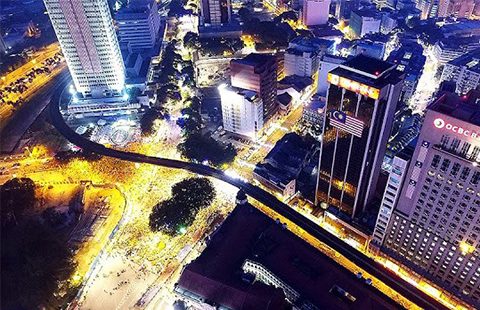As Malaysia’s Bersih 4 rally on the weekend shows, people power in the 21st century is best captured by drone journalism and social media.
If Marshall McLuhan was right, and the medium is the message, last weekend’s Bersih 4 rally in Malaysia prompts us to ask: which medium best conveys the message of ‘people power’?
Traditionally, media reports convey ‘people power’ through crowd numbers: 75,000? 100,000? 200,000! These numbers are always estimates and are usually disputed by authorities. And how do we make sense of these numbers anyway? Other studies have shown that news coverage of protests are often framed around violence or conflict, which does not reflect the cause or overall atmosphere of the day, but rather simply provide a sensationalist snippet for the nightly news.
Thus, the answer as to which medium conveys the most effective message of a mass movement seems to lie more in social media. As scholars have argued previously, the organisation of a modern-day mass rally depends so much on the dissemination of information via social media platforms such as Facebook and Twitter.
Throughout the Bersih4 rally, organisers kept everyone up to date as to events and instructions, and ‘ordinary’ citizens at the rallies became ‘prod-users’ (from Bruns, as in someone who produces media as well as consumes it). Malaysians engaged in a form of citizen or participatory journalism if distributing images of the rally via social media. All of these ‘crowd-sourced’ images are important, particularly in Southeast Asia where social media is used widely amongst young people.
However, it seems that the key mediated message of the mass movement currently lies in the more professional media – through the panoramic, birds-eye photo.
Who could forget this shot (below) of Joko ‘Jokowi’ Widodo speaking to supporters in the 2014 Indonesia elections? The Salam Dua Jari Concert (pictured below) was held the weekend before election day, in what was an incredibly tight race between Jokowi and presidential rival Prabowo Subianto.
The image conveyed something missing from Jokowi’s campaign previously; it made him seem Presidential. He was no longer the small-town mayor travelling from town to town ‘pressing the flesh’ with locals. The photo portrays him as the candidate with broad popular support. It made the front page of major newspapers and was spread widely on social media platforms. It was even on the home page of Twitter after Jokowi went on to win the election.
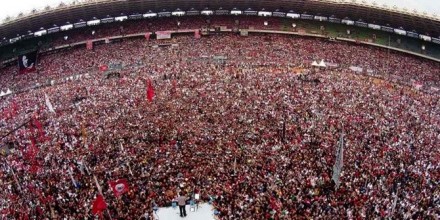
During the Thai demonstrations in 2013, it has been argued that the panoramic shots (see below) provided a perspective on the rallies that had previously been lacking in the country’s media reports.
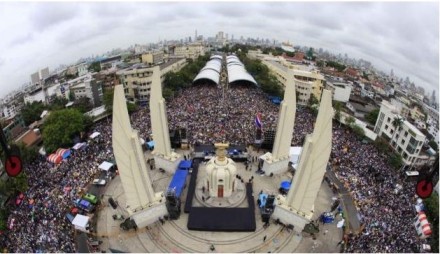
In Malaysia too, as many government-controlled websites do not publish significant details of the Bersih rallies, these panoramic images become even more important.
At the Bersih rally at the weekend, news organisations which covered the rally knew the panoramic shot would be an important part of their coverage. Below are two from English-language news sites. Note how news organisations made sure they copyright these images, such is added publicity for these shots, given that their value lies in social media shares.
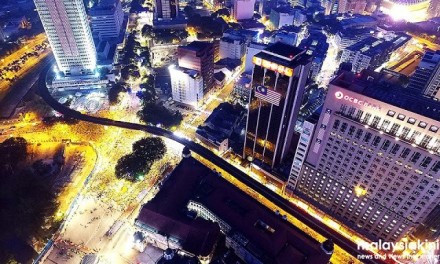
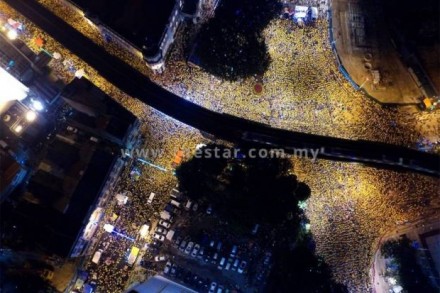
In Spreadable media: creating value and meaning in a networked culture, Jenkins, Ford and Green argue that ‘if it doesn’t spread, it’s dead’.
Large-scale social movements need ways to convey their ‘value’ and ‘meaning’ through images which reflect the scale and message of the event, to be distributed via social media platforms.
As you can see, when done well, filling the image is the key, conveying a protest bursting at the seams; as is colour, showing a crowd united in the common cause. It perhaps gives some idea as to why the Malaysian government tried to ban the Bersih yellow t-shirt.
While previously these shots usually relied on helicopters or perhaps an enterprising journalist climbing to the top of a large structure, now the increasing trend is for small, remote-controlled drones that capture these images (see below). In 2015, authorities in Southeast Asia have discussed the licensing and registration of drones, but to what extent they will try to stop media organisations from having them will be an interesting development to follow in the coming months.
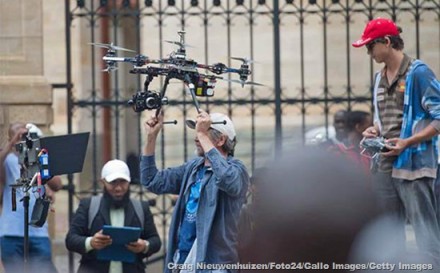
In short, ‘drone journalism’ (to use the term loosely) spread via social media platforms, is becoming a feature of current-day mass rallies in Southeast Asia and seems to most compellingly convey the message of ‘people power’ in the region. They are widely shared and represent popular movements in a region where ordinary citizens are urging for significant reforms.
Dr Ross Tapsell is a lecturer in the School of Culture, History and Language at the ANU College of Asia and Pacific.
 Facebook
Facebook  Twitter
Twitter  Soundcloud
Soundcloud  Youtube
Youtube  Rss
Rss 